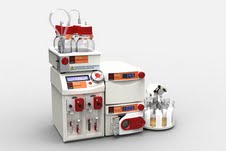Home > Press > Syrris microreactors used for continuous-flow nanoparticle synthesis
 |
Abstract:
Researchers around the world are realizing the benefits of the Asia flow reactor range from Syrris, the world's leading provider of laboratory scale flow chemistry systems, for the synthesis of nanoparticles. Already widely adopted by organic chemists, this innovative flow microreactor system is now being used to provide fast and reproducible continuous formation of nanoparticles, quantum dots and colloidal metals.
Syrris microreactors used for continuous-flow nanoparticle synthesis
Royston, UK | Posted on August 29th, 2012Flow chemistry offers a number of advantages over traditional batch-based techniques for nanoparticle synthesis, due to the small internal diameter and extremely high surface-to-volume ratio within the microreactor. These characteristics ensure fast, efficient mixing and accurate temperature control for more consistent and reproducible results. The modular design of the Asia flow reactor range also offers easy scalability and exceptional process flexibility, as well as providing convenient and straightforward set-up of pressurized and multi-step processes.
Paulina Lloret, a researcher from the Instituto Nacional de Technología Industrial in Argentina, commented: "We trialed our nanoparticle experiments on the Asia flow chemistry system during a visit to Syrris' UK facilities, and immediately placed an order for our own system. We are looking forward to performing our synthesis on the Asia, which will help us to optimize the speed and results of our synthesis workflow."
For more information, visit syrris.com/videos/iron-magnetic-nanoparticle-synthesis-video
####
About Syrris Limited
Syrris is world renowned for excellence in chemical reactor systems and is a world leader in flow chemistry systems. Established in 2001, Syrris employs over 30 scientists and engineers at its facility in Royston (near Cambridge, UK) and has offices in the US, Japan, India and Brazil plus over 30 distributors worldwide.
Syrris develops laboratory automation products for research and development chemists in industries such as pharma, petrochem, agrochem, fine chemical synthesis etc. as well as academia. Syrris products are used in a wide variety of applications and laboratories including process, discovery, crystallization, process safety, scale-up and many more.
Syrris products include the innovative range of fully automated batch reactor products (Atlas), a manually operated jacketed reactor platform (Globe) and flow chemistry systems (Asia and Africa). In recognition of its technological achievements, Syrris has been awarded the “Eastern Region’s UKTI Best Established Exporter” and the “Most Outstanding Export Achievement” at the Global Opportunity Conference on International Trade.
For more information, please click here
Contacts:
Sarah Ballard
kdm communications limited, St Neots, UK
Tel. +44 (0)1480 405333
Fax: +44 (0)1480 477833
Copyright © Syrris Limited
If you have a comment, please Contact us.Issuers of news releases, not 7th Wave, Inc. or Nanotechnology Now, are solely responsible for the accuracy of the content.
| Related News Press |
News and information
![]() Researchers develop molecular qubits that communicate at telecom frequencies October 3rd, 2025
Researchers develop molecular qubits that communicate at telecom frequencies October 3rd, 2025
![]() Next-generation quantum communication October 3rd, 2025
Next-generation quantum communication October 3rd, 2025
![]() "Nanoreactor" cage uses visible light for catalytic and ultra-selective cross-cycloadditions October 3rd, 2025
"Nanoreactor" cage uses visible light for catalytic and ultra-selective cross-cycloadditions October 3rd, 2025
![]() Researchers tackle the memory bottleneck stalling quantum computing October 3rd, 2025
Researchers tackle the memory bottleneck stalling quantum computing October 3rd, 2025
Chemistry
![]() "Nanoreactor" cage uses visible light for catalytic and ultra-selective cross-cycloadditions October 3rd, 2025
"Nanoreactor" cage uses visible light for catalytic and ultra-selective cross-cycloadditions October 3rd, 2025
![]() Cambridge chemists discover simple way to build bigger molecules – one carbon at a time June 6th, 2025
Cambridge chemists discover simple way to build bigger molecules – one carbon at a time June 6th, 2025
Announcements
![]() Rice membrane extracts lithium from brines with greater speed, less waste October 3rd, 2025
Rice membrane extracts lithium from brines with greater speed, less waste October 3rd, 2025
![]() Researchers develop molecular qubits that communicate at telecom frequencies October 3rd, 2025
Researchers develop molecular qubits that communicate at telecom frequencies October 3rd, 2025
![]() Next-generation quantum communication October 3rd, 2025
Next-generation quantum communication October 3rd, 2025
![]() "Nanoreactor" cage uses visible light for catalytic and ultra-selective cross-cycloadditions October 3rd, 2025
"Nanoreactor" cage uses visible light for catalytic and ultra-selective cross-cycloadditions October 3rd, 2025
Tools
![]() Japan launches fully domestically produced quantum computer: Expo visitors to experience quantum computing firsthand August 8th, 2025
Japan launches fully domestically produced quantum computer: Expo visitors to experience quantum computing firsthand August 8th, 2025
![]() Rice researchers harness gravity to create low-cost device for rapid cell analysis February 28th, 2025
Rice researchers harness gravity to create low-cost device for rapid cell analysis February 28th, 2025
Quantum nanoscience
![]() ICFO researchers overcome long-standing bottleneck in single photon detection with twisted 2D materials August 8th, 2025
ICFO researchers overcome long-standing bottleneck in single photon detection with twisted 2D materials August 8th, 2025
![]() Programmable electron-induced color router array May 14th, 2025
Programmable electron-induced color router array May 14th, 2025
|
|
||
|
|
||
| The latest news from around the world, FREE | ||
|
|
||
|
|
||
| Premium Products | ||
|
|
||
|
Only the news you want to read!
Learn More |
||
|
|
||
|
Full-service, expert consulting
Learn More |
||
|
|
||








